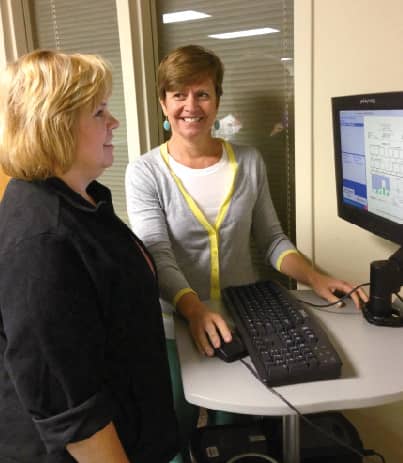Physical therapists team with audiologists to close the circle on dizziness and balance disorders at the University of Tennessee’s Balance and Hearing Center
by Kristy T. Hoffecker, MA, CCC-A, and Christie M. Noe, PT

The Balance and Hearing Center utilizes a team approach to diagnose and treat dizziness and balance disorders.
The team consists of physical therapists, audiologists, and otolaryngologists. Each discipline brings its own perspective and information to the diagnostic and treatment process. A physical therapist evaluates vestibular function, vision, sensation, and the brain’s ability to utilize information from these systems to maintain balance. The therapist also tests balance, strength, motion sensitivity, coordination, eye function, and functional activities. An audiologist assesses how well the inner ear is responding to auditory and vestibular input. An otolaryngologist (ear, nose, and throat doctor) evaluates a patient, orders necessary diagnostic tests, prescribes necessary medications, and discusses surgical options, if needed.
TEAM EFFORT
It is the team approach employed at the Balance and Hearing Center that distinguishes the facility. The basic test battery for balance patients includes videonystagmography (VNG) and a physical therapy examination with a qualified vestibular therapist. When the PT has the VNG results prior to the physical therapy evaluation, it determines whether there is vestibular involvement in the dizziness or imbalance. This not only can direct treatment in a more effective way, it also provides an important tool to educate patients about their condition, which can improve their understanding and decrease confusion and anxiety. Most patients treated at the Balance Center experience a reduction in symptoms, improvement in function, and better understanding of their condition. The goal is to restore patients to the highest possible level of independence and autonomy and to encourage well-maintained fitness and balance. Additional testing can be performed depending on the patient’s needs, including audiometric testing, platform posturography, vestibular evoked myogenic potentials, electrocochleography (ECOG), and auditory brainstem response (ABR) testing.
Since all tests are done in the same facility, communication between disciplines is immediate. This flow of clear information between audiologist and physical therapist results in better care and more efficient care for the patient. These two disciplines are not always housed together in medical facilities, which can make diagnosis and treatment more disjointed.
In addition to the Balance Center team’s daily communications, its members meet once a week to discuss every patient who has been referred for evaluation and treatment. At this meeting, the center’s director, otolaryngologist William Horton, MD, consults with the audiologists and physical therapists to hear salient evaluation findings, discuss possible courses of treatment, and suggest further medical evaluation in other specialty areas when appropriate. Involving three different medical perspectives and scheduling time for face-to-face conversation open the way to concrete problem-solving and provide unique benefits to patients, especially to those whose conditions are complex.
“The causes of and variability in dizziness are so broad that the team approach is the only way to consistently identify the diagnosis and most effective treatment,” explains Kristine Nevans, PT. “This is really medicine at its best—thorough communication between three overlapping fields of expertise to arrive at a singular conclusion and plan of action.”
Following are examples of successful outcomes achieved by the Balance and Hearing Center’s unified approach:
CASE #1
Patient A, aged 55 years, first came to the Balance Center in November 2012 with complaints of episodic dizziness since 1990. She had experienced a decrease in her hearing the previous July as well as episodic dizziness. Audiometric testing in August 2012 showed normal hearing in the right ear and a mild sensorineural hearing loss in the left ear. Patient A had a VNG, ECOG, and ABR in November, revealing a 19% left unilateral vestibular weakness and an abnormal ECOG on the left, leading to the diagnosis of Meniere’s disease in the left ear.
When Patient A came to physical therapy in December 2012, to address her motion-provoked symptoms and imbalance, all testing was already on hand, and face-to-face communication was possible between the treating therapist and audiologist. Any questions about the audiological testing were readily answered in a conversation before she was evaluated by the physical therapist. In a more complex case such as this, where patient education is a critical part of treatment, having both disciplines on hand to answer questions creates a situation where patient understanding is more likely. Patient A progressed well in therapy and was discharged in December 2012.
This patient was treated with habituation and progressive vestibular-ocular reflex (VOR) exercises to address her symptoms of imbalance and motion-provoked symptoms. She was symptom free at the time of discharge and demonstrated no functional balance deficits.
In March 2013, Patient A made the decision to have a Gentamicin perfusion in her left ear in an attempt to avoid any more episodes of vertigo secondary to Meniere’s disease. She returned for physical therapy a week after the perfusion with symptoms of dizziness and imbalance. Patient A demonstrated objective changes and gains in therapy without corresponding subjective changes. Her MD referred her back for a repeat ECOG and VNG to re-evaluate the function of the left ear. Once again, having the patient return to the same facility, and see the same audiologist and physical therapist, assured her continuity of care.
The team decided that medical management was most appropriate for this patient, given her lack of subjective gains in therapy.
Having the face-to-face conversation between disciplines allows each health care provider to have a more complete picture of what is happening with the patient, and ensures team members are on the same page clinically as the patient is educated.
CASE #2
Patient B, aged 60 years, awoke one morning with extreme vertigo, nausea, vomiting, and imbalance. When his symptoms did not subside, he was transported by ambulance to the emergency department. All testing was normal, and an ENT consult recommended vestibular testing on an outpatient basis.
A VNG performed at the Balance and Hearing Center demonstrated a 45% left unilateral weakness, and the audiologist recommended he receive vestibular physical therapy for his residual symptoms. He was evaluated within the week by a physical therapist.
Having the VNG report in hand before seeing the patient, and being able to discuss the case with the audiologist, gave the therapist insight into this case that would not have otherwise been available. Although the physical therapist bases the treatment on clinical signs, the ability to have a discussion with the patient about the cause of the symptoms with objectivity and certainty provides a better level of understanding for the patient than he would have had without the vestibular testing performed by the audiologist. This leads to better patient care and communication, which can lead to better outcomes. Even in this straightforward case, the ease of communication and having the objective test results on hand led to a better experience for the patient and a more informed plan of care from the treating health care providers.
This patient was treated with progressive VOR exercises and habituation exercises to ease his dizziness and motion-provoked symptoms. After treatment, he was able to return to his job, which he was unable to do when he was dizzy, because of the physical nature of the work.
CASE #3
Patient C, aged 51 years, was seen in November 2011-January 26, 2012 with diagnosis of a right acoustic neuroma, for therapy to improve her balance. At the time, her treating physician did not feel she was appropriate for surgery so therapy was ordered to maximize function while awaiting surgery. She presented with no motion-provoked symptoms and significant VOR insufficiency, which made ambulating with head motion and in busy visual environments very difficult. She also had an abnormal Clinical Test of Sensory Integration and Balance (CTSIB) in conditions 2 and 4 on a balance device that uses forceplates and rotation to perform assessment. Treatment included progressive gaze stabilizing exercises with varying backgrounds and standing surfaces. She was encouraged to increase her reliance on proprioceptive clues through balance activities where visual input was minimized.
Despite compliance with the exercise program and plan of care, this patient demonstrated minimal improvements with her balance and was referred back to her physician. She had surgery on June 12, 2012 to remove the acoustic neuroma and returned to therapy on July 31, 2012. Static balance was better on this visit than on discharge after the last round of therapy. CTSIB on the balance system was normal in all four conditions, which is an improvement over discharge from the previous January. The patient was making enough progress with her balance that she was able to return to work. She works as a hairdresser and expressed frustration with the inability to communicate with her clients in a busy salon and the amount of fatigue she was experiencing after working. She was able to see only one to two clients a day where before she was seeing seven to eight clients a day. The physical therapist was unsure whether there was anything available to help her with this issue. During her treatment session, the PT had an audiologist join them to ask whether there were treatment options to help with the communication issues. The patient’s amplification options were discussed following her physical therapy treatment session and she decided not to pursue amplification at that time.
In April 2013, the patient returned to discuss amplification options. She has normal hearing in the left ear and no measurable hearing in the right ear since surgery. She reported she still has difficulty with fatigue and communicating in busy places. She decided to order a hearing aid that uses Contralateral Routing of Signal (CROS). This technology is designed to pick up sound from the side that has no hearing and send the information to the ear that has hearing. CROS allows users to feel as if they are hearing from both ears, though all of the sound is processed by the hearing ear. She was fit with the CROS aid in mid April. After 2 weeks, she returned for a follow-up visit and reported she feels an improved energy level after wearing the aids. She noted the hearing is not perfect, but she is not constantly straining to hear what is said and from where it is coming. If audiology and physical therapy were not in the same physical location, she probably would never have pursued amplification. Since she was familiar with the location and comfortable with the staff, she returned when she was ready.
The University of Tennessee Medical Center Balance and Hearing Center strives to provide exceptional collaborative patient care, and the strength of its multidisciplinary approach continues to be key in optimizing treatment of dizziness and balance disorders. RM
Kristy T. Hoffecker, MA, CCC-A, is clinical manager of audiology at the University of Tennessee Medical Center in Knoxville. She holds a bachelor of arts degree in communication disorders from the University of Tennessee and a Master of Art in Audiology from the University of Tennessee.
Christie M. Noe, PT, is the clinical manager of outpatient physical therapy at the University of Tennessee Medical Center, Knoxville. She holds a bachelor of science degree from the University of Tennessee in kinesiology and a master of physical therapy from the University of St. Augustine. For more information, contact [email protected].




